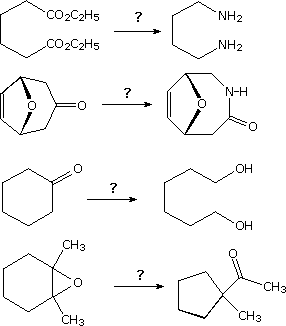| 1. |
 | |
Reaction Conditions A (i) C6H5CO3H in CH2Cl2; (ii) LiAlH4 in ether; (iii) H2O
B (i) LiAlH4 in ether; (ii) H2O; (iii) C6H5CO3H in CH2Cl2
C H2SO4 (catalyst) in CH3CN
D (i) NH2OH (oxime formation) (ii) strong acid or PCl5 (Beckmann rearrangement)
E NH4OH + NH4Cl in water; heat to reflux
F (i) N2H4 (excess) (ii) HNO2; H3O(+); 5° C
G (i) C7H7SO2Cl in pyridine (ii) Acetone + H2O, 50° C |